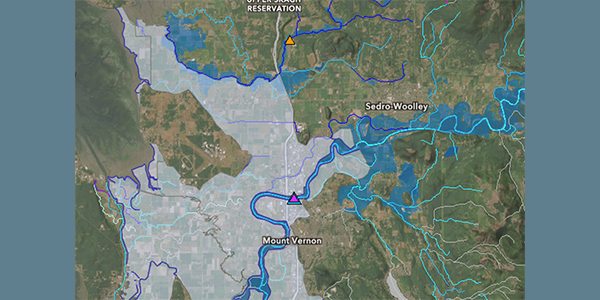State Economist paints mixed picture of economic future: Strategist warns of “asymmetric trade”
Attempting to look through the windshield at what’s ahead and the rear-view mirror at statistics, Washington State Chief Economist Aru Raha gave a concise overall view of Washington State’s economic picture at a luncheon April 4, in Friday Harbor.
Raha gave a “bottom line” date of October 2013 before the state’s economy returns to the level of health it experienced in February 2008, before the current recession began. Although the recession “officially” ended in June 2009, factors since then have made for a slow recovery, now exacerbated by natural and energy disasters in Japan and political unrest in countries bordering the south-east rim of the Mediterranean.
Cautioning that predictions “especially about the future” are by their nature unreliable, Raha told the audience in Friday Harbor, brought together by the Economic Development Council and the Washington State Commerce Department, that the current recession is the worst economic downturn since the Great Depression of the 1930s.
The expected state General Fund revenues have been lowered by $85 million in the current bi-ennium, which ends June 30 this year, and the state forecasts that the downturn will result in $698 million shortfall in 2011-2013.
Recovery remains fragile, with
- Slow job growth
- Lagging construction industry
- Geopolitical events
Since revenue and expense statistics are not available for several months, the impact of recent events in Japan and North Africa, the Arabian Peninsula and the Mideast are unknown. However with state revenue dependent in great part upon people buying consumer items and paying retail taxes, already some of the consequences are apparent:
- Japan is Washington’s third-largest trading partner; purchases of cars, machine parts and electronics lead the trade that has been interrupted by Japan’s recovery from the destruction caused by the March 11 earthquake and tsunami.
- Consumer confidence (the likelihood of people spending money) is substantially impacted ( 25 percent) by the price and availability of gas; conflicts in the Mid-East erode that confidence.
Raha introduced the topic of inflation by saying, “inflation fighters are the people who, if the party gets going, will take the punchbowl away.”
He distinguished between two categories of inflation:
- Core inflation, which excludes food and energy. Core inflation stability depends on inflation expectations, “If there is no demand for higher prices and the core is stable, there is no inflation.” Raha expects this to be the situation until the end of 2011;
- All inflation, which includes food and energy costs.
Raha displayed graphs that showed the gross domestic production has grown for six consecutive quarters; however, the growth has not been linked with employment recovery.
Construction jobs in particularly have been impacted by the freeze in credit attendant on the recession: non-residential construction in Washington state declined by 33 percent in 2009, and by 18 percent in 2010. Raha expects this segment of construction will “pick up” by 2012.
Home sales
Further graphs indicate that there is a second downward trend in home prices, or a “double-dip.” Rising foreclosure rates will keep housing prices depressed this year.
And although Seattle and Washington State have lower rental vacancy rate than the rest of the nation; the housing market will not recover until home prices start to rise. The increase in home prices depends on the supply-demand scenario of new household formation. Kids and grandkids who are moving back home are what we are seeing now, instead of new household formation. Raha projects that the demand for housing won’t pick up until employment rates increase.
On that horizon there are two factors that offer hope for a continued economic recovery to state residents:
1) Boeing aircraft orders extend into 2018, and the company is hiring at the rate of 400 employees a month;
2) Software development and publishing is expected to grow five percent per year
Job growth will benefit from small business success, in that, since 1992, two-thirds of jobs have been in the small business sector. Since February 2008, when the state went into recession, it is expected to take 5.5 years, or until 2013, before state employment returns to 2008 employment levels.
The fact that multi-unit housing is picking up is a good sign, as is the increase in immigration to the state. But Raha repeated that housing has not hit bottom even though employment rates are improving and productivity is growing.
Overall, though export growth is stable and “will help the state outperform in the recovery,” Raha warned, “Japan’s impact is significant.”
It’s a whole new world for state revenue,” he said.
To read a similar presentation which Raha gave earlier, go to www.tvw.org/media/mediaplayer.cfm
Mark Anderson, the CEO of the Strategic News Service® (SNS), and the founding chair of the Future in Review® (FiRe) Conference, which the Economist has labeled “the best technology conference in the world,” followed Raha’ talk with a presentation on “The Effects of Economic Cyberwar on Global and Local Economics.
Anderson began his talk by advocating that wide broadband access could accelerate local business growth.
He outlined the dangers of national trading partners who follow a “mercantilist” model, where one partner’s gain is at the expense of the other partners’ loss.
In particular, he singled out the practice of “trade targets” exemplified by China, which obtains the intellectual property of U.S.-made products and then manufactures them for export sales at greatly-reduced prices. He cited everyday products such as television, cars, electronics and cellphones as examples of this practice, and said that the Chinese have obtained nuclear capability, anti-ballistic missiles, car engine and other technologies through this policy, which he characterizes as “indigenous innovation.”
A recent Reuters U.S. report stated, “U.S. concerns about China’s policies to promote domestic innovation by imposing unfavorable terms on foreign companies will be a major topic at high-level bilateral talks this month in Beijing, a top U.S. official said on Wednesday.
“We will be raising the issue of indigenous innovation … throughout the trip, including at the S&ED” (Strategic & Economic Dialogue) meeting, U.S. Commerce Secretary Gary Locke told reporters ahead of a clean energy trade mission he is leading next week to China.
The policies of indigenous innovation are “aimed at increasing China’s share of the world’s most valuable patents and trademarks by requiring companies to develop and register intellectual property in China to qualify for certain government procurement preferences,” the Reuters U.S. article states.
Anderson said that intellectual property is “the core value of civilization in the modern world,” and that China’s rise from a poor and undeveloped country to a powerful and rich nation is due to its appropriation of U.S. intellectual property.
Like what you just read? click here: https://theorcasonian.com/donate
**If you are reading theOrcasonian for free, thank your fellow islanders. If you would like to support theOrcasonian CLICK HERE to set your modestly-priced, voluntary subscription. Otherwise, no worries; we’re happy to share with you.**







